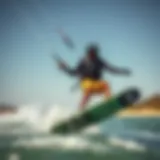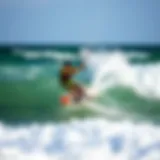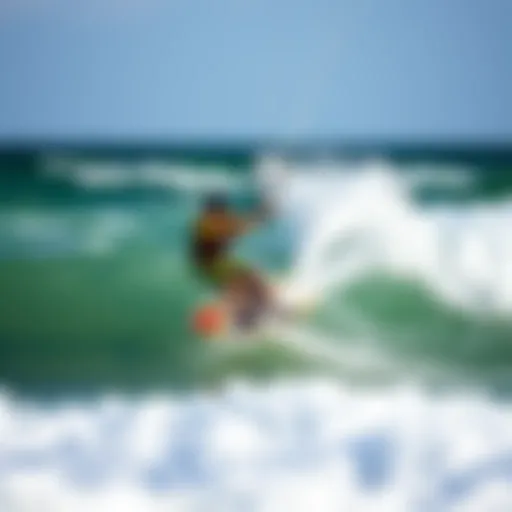Freestyle Boards: The Ultimate Guide for Kiteboarders
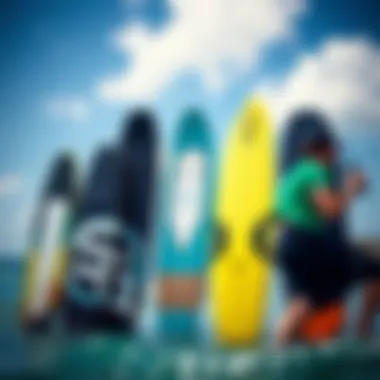
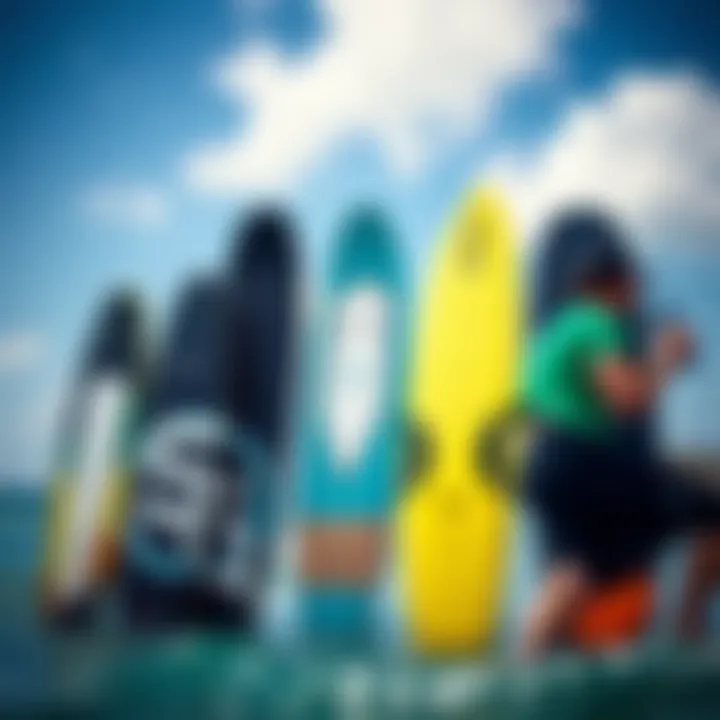
Gear Insights
Understanding Freestyle Boards
Freestyle boards are an essential piece of gear for kiteboarders who wish to express their creativity on the water. Designed for jumping, spinning, and performing tricks, these boards typically feature a flatter rocker and a more flexible body compared to their freeride counterparts. This design allows for better pop and easier landings, which is fundamental to executing complex maneuvers with grace.
When selecting a freestyle board, it’s vital to consider the type of riding you plan to do. A board that is too rigid may bolster speed but can hinder the flexibility needed for tricks. On the flip side, an overly soft board might enhance maneuverability but sacrifice top-end performance.
Latest Gear Reviews
In the ever-evolving world of kiteboarding, several brands have made headlines with their latest freestyle offerings. For instance:
- North Rebel 2023: This board stands out due to its innovative flex pattern, enhancing pop while maintaining stability during landings.
- Duotone Team Series: Known for its durability, this board is crafted for advanced riders who demand performance in various conditions.
- Slingshot Misfit: A versatile option for intermediate kiteboarders, it packs a playful punch while remaining forgiving for those still honing their skills.
Each of these boards caters to different skill levels and styles, so understanding the nuances in performance is a must for any serious kiteboarder.
Essential Gear for Beginners
If you're just dipping your toes into kiteboarding, selecting the right gear can feel overwhelming. Here are some fundamentals:
- Sturdy Harness: A good harness supports your body, allowing you to control the kite with minimal fatigue.
- Helmet and Impact Vest: Safety always comes first, especially while learning new tricks.
- Kite Size: Choose a kite that matches your weight, skill level, and local wind conditions. A smaller kite may be easier to handle in high winds, while a larger kite is better suited for lighter breezes.
This basic setup will instill confidence as you learn the countless tricks freestyle boards can help you perform.
"Choosing the right gear is just as crucial as mastering the tricks themselves. Invest wisely, and your rides will be all the more enjoyable."
Understanding which freestyle board suits your style and ability can make all the difference. As you progress, consider the materials and construction of the boards you’re interested in to find the right fit for your adventures on the water.
Stay tuned for the next section where we’ll explore techniques and tips to up your kiteboarding game.
Intro to Freestyle Boards
Freestyle boards hold a pivotal place in the realm of kiteboarding, acting as the backbone of the freestyle discipline. In this section, we shall explore the essence of freestyle boards, discussing their significance and the various dimensions that come into play. Understanding the purpose and evolution of these boards not only enhances one's appreciation of the sport, but it also equips riders with the knowledge to choose the perfect board that aligns with their riding style.
Definition and Purpose
Freestyle boards are specifically designed for executing tricks and maneuvers in the air and on the water. Unlike traditional kiteboards, which may cater to various styles including cruising and wave riding, freestyle boards prioritize responsiveness, pop, and the ability to withstand the impact of landings. They typically feature a flatter bottom and narrower shape, creating a surface ideal for lifting off and generating speed.
The core purpose of a freestyle board is to enhance the rider's performance and confidence in executing complex aerial tricks. They enable the rider to allocate their energy efficiently, making challenging maneuvers feel more accessible. If you're looking to spin, flip, or glide through the air, the right freestyle board can significantly bolster your capabilities.
The Evolution of Freestyle Boards
The history of freestyle boards is a narrative of innovation and adaptation. Early board designs were rudimentary, often made of heavy materials that restricted movement and performance. Riders quickly realized that flexibility and lightweight construction were essential for advanced tricks. This need led to the advent of newer materials, such as composites and lighter woods, which drastically improved performance.
Over the years, diverse cultures and regions influenced the evolution of these boards. For instance, in the early days of kiteboarding, riders in Hawaii favored boards with a wide outline for stability, while European riders preferred a more tapered design for speed and agility. This geographic divide propelled manufacturers to experiment with various shapes and sizes, ultimately giving rise to a vibrant industry of freestyle board designs.
Today, brands continuously push the envelope with advanced technology. Features like adjustable fins, carbon fiber reinforcements, and even customizable flex patterns are now the norm. This evolution reflects a deep understanding of rider preferences and the continuous quest for performance enhancement.
"The world of freestyle boards is a testament to how innovation and rider feedback can shape an entire sport." - Kiteboarding Insider
In summary, freestyle boards are not just tools for kiteboarding enthusiasts; they encapsulate a journey of exploration and improvement within the sport. As we delve deeper, understanding these fundamental concepts will guide you toward making informed choices that enhance your kiteboarding adventures.
Key Features of Freestyle Boards
Freestyle boards play a crucial role in kiteboarding, combining a range of features that cater to the specific demands of this thrilling sport. Understanding these features allows riders to make an informed choice about which board suits their style and environment best. From shaping to material, every component influences the performance on the water.
Shape and Design
Outline Variations
The outline of a freestyle board significantly affects how it performs during tricks and jumps. Boards generally feature varied outlines, such as a wider nose or a narrower tail. These shapes influence maneuverability and stability.
For example, boards with a wider nose often provide better tracking in choppy conditions, reducing drag during high-speed runs. However, they may feel less agile during technical tricks and landings. On the flip side, narrower boards allow for quicker turns and sharper spins, making them popular among riders who prioritize freestyle capabilities.
The unique feature here is how the outline interacts with the water—some boards are designed to slice through waves, while others glide more smoothly, a choice depending on whether speed or trick performance is paramount.

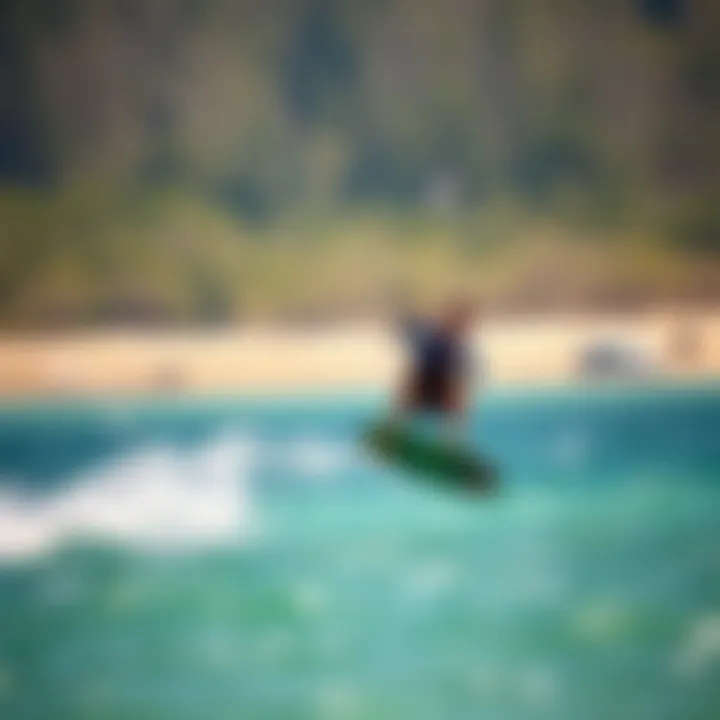
Tail Design
The tail design significantly dictates a board’s behavior on the water. Boards with a straight tail offer a more predictable ride, perfect for beginners. In contrast, a squarer tail allows for explosive pop during jumps, making it a favored choice for seasoned kiteboarders looking to impress.
One unique characteristic is the stepped tail, which provides additional grip while turning, enabling advanced tricks to be executed more smoothly. The disadvantage, however, is that such designs may sacrifice some speed in favor of maneuverability, which might affect performance in racing conditions.
Rockers and Flex Patterns
Rockers refer to the curvature of the board from tip to tail. A pronounced rocker often means better performance in waves and enhanced pop off the water, crucial for achieving higher jumps. On the other hand, flatter boards generate more speed, letting riders glide across the water effortlessly.
Flex patterns also come into play. Softer flex makes for a more forgiving ride, absorbing impacts during landings—a boon for freestyle riders. However, a stiffer board provides better responsiveness during high-speed maneuvers, appealing to those looking for precision and control.
Material Composition
Wood vs. Composite Materials
The material used in constructing freestyle boards often defines their durability, weight, and cost. Wood boards are typically heavier but offer warmth and a natural feel that many riders appreciate. They tend to dampen vibrations, giving a smoother ride over choppy waters, which can be beneficial in rough conditions.
On the other hand, composite materials—like fiberglass or carbon fiber—are generally lightweight and provide enhanced stiffness. This stiffness translates to better performance but can feel less forgiving during trick execution. Consequently, riders must weigh the benefits of durability and performance against personal preference in feel and handling.
Durability Considerations
Durability is an essential aspect of a freestyle board, especially for those who push their limits. With frequent impacts from jumps and landings, choosing robust construction is crucial.
A key advantage of durable boards is their ability to withstand wear and tear over time, ensuring that they perform consistently as they age. However, it’s important to note that while high-durability boards might cost more upfront, they generally save money in the long run due to a lower replacement rate.
Sizing and Volume
Determining the Right Size
The size of a freestyle board can profoundly influence a rider’s performance. Generally, the choosing process involves taking into account the rider’s weight, skill level, and intended style. For instance, heavier riders or those looking to ride in gusty conditions might opt for a larger board. In contrast, lighter riders may find more agility with a smaller board.
One unique aspect of sizing is that it affects how quickly the board responds to movements, influencing both speed and control. Mismatching board size to rider weight can lead to a less enjoyable riding experience, as the performance may not meet expectations.
Impact of Volume on Performance
Volume plays a vital role in how a board performs, affecting buoyancy and stability in the water. A higher volume board floats better, making it easier to stay on top of the water, especially for new riders. In contrast, lower volume boards can feel quicker, appealing to competition-level riders looking for speed and maneuverability.
A distinguishing feature of higher volume boards is their suitability for various riding conditions. They tend to handle rough waters better, reducing the fatigue often associated with challenging conditions. Nonetheless, they can occasionally feel bulky for tricks, which might hinder advanced freestyle riders looking for precision.
Performance Characteristics
Understanding the performance characteristics of freestyle boards is essential for any kiteboarder looking to enhance their riding experience. These attributes influence how the board behaves in various conditions and during different maneuvers. The speed, agility, pop, response, stability, and control all play a crucial role in determining how effectively a rider can perform tricks and navigate through the water. Having a grip on these elements ensures that both beginners and advanced riders can choose a board that complements their style and goals.
Speed and Agility
Speed is often the lifeblood of any good kiteboarding session. A board designed for freestyle should not only allow for rapid movement but also for quick transitions. Riders rely on boards that can cut through water with ease, as this impacts their overall performance dramatically. When speed is balanced with agility, kiteboarders can react swiftly to the changing conditions, such as wind shifts or waves.
In essence, speed boosts the rider's ability to take off for jumps or tricks with more vigor. Boards with a thinner outline often exhibit greater speed because they generate less drag. Moreover, the way a board is shaped can affect its maneuverability. More pronounced rocker, for instance, can enhance quick movements, making it easier for riders to initiate tricks and spins.
Pop and Response
Pop refers to the board’s ability to launch off the water. This is a critical facet for freestyle riders, as it directly affects how high and how explosively they can jump. A board with excellent pop will generate significant lift, allowing a rider to achieve greater heights during aerial tricks.
However, pop does not operate in isolation; it is intricately linked to the board’s responsiveness. How well a board responds to the rider's inputs is integral to executing tricks effectively. A responsive board reacts immediately to changes in weight distribution, enabling riders to adjust mid-air and land safely. When assessing a board, potential buyers should consider the flex pattern as well as construction materials, as these factors contribute significantly to the pop and response a board can offer.
Stability and Control
When riding at high speeds or executing complex maneuvers, stability becomes paramount. A stable board provides a solid platform, preventing unwanted wobble that could throw off a rider's balance. This stability often comes from a wider outline or a flatter rocker, both of which help distribute weight evenly and minimize the risk of nosediving.
Control is closely tied to stability. A well-balanced board enables precise steering and the ability to maintain direction even in chop or turbulent conditions. Many riders find themselves in scenarios where they need to adjust course quickly. Here, a responsive layout, along with quality fins, can play a significant role in maintaining control over the board.
Freestyle vs. Other Board Types
When it comes to kiteboarding, choosing the right board makes all the difference in the world. Differentiating freestyle boards from other types is a pivotal part of ensuring your riding experience aligns with your style and intentions on the water. Each board serves its own purpose, boasting unique features and performance characteristics, which can significantly influence how a rider interacts with their environment. By understanding these differences, kiteboarders can make informed decisions, enhancing both their performance and enjoyment.

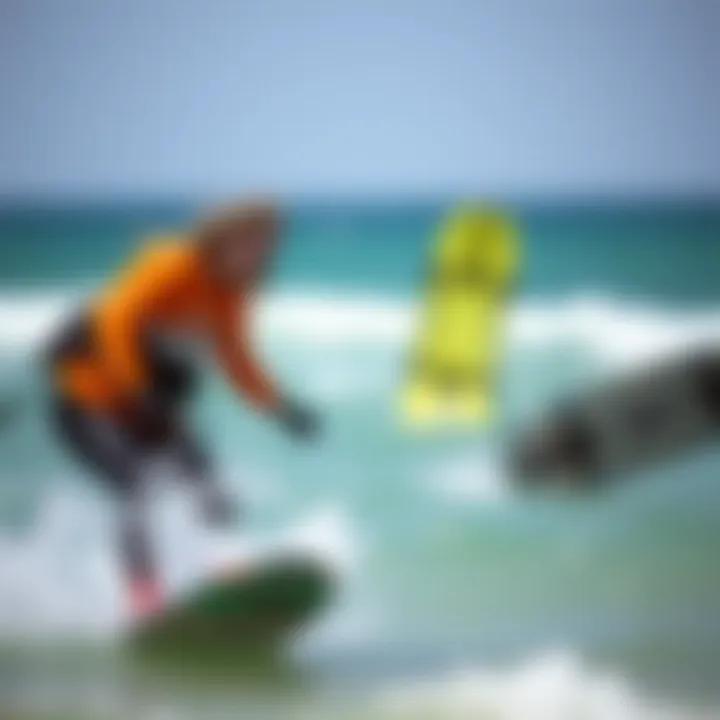
Comparative Analysis
All-Around Boards
All-around boards present an intriguing balance between versatility and performance, making them a popular choice among kiteboarding enthusiasts. These boards are designed to handle various conditions, allowing riders to tackle different styles of riding with ease. Their key characteristic lies in their adaptability; they perform well whether you're cruising through flat waters or attempting basic tricks in choppier conditions.
What sets all-around boards apart is their moderate size and flex, striking a balance that appeals to beginners and intermediates alike. This flexibility can be seen as a double-edged sword; while it gives the board a forgiving touch, making it easier for new riders to learn, it might lack the precision that advanced techniques require. Therefore, if you're seeking a board that will grow with your skills while still allowing you some fluid fun, an all-around option may just be what you're looking for.
Freeride Boards
On the other hand, freeride boards offer a specialized experience, focused on speed and smooth rides across a variety of water conditions. These boards are generally longer and include a specific edge design that maximizes their performance when cutting through water. A defining characteristic of freeride boards is their ability to glide smoothly during long runs, making them especially appealing for those chasing the thrill of speed.
A unique feature of freeride boards is their increased surface area, which aids in flotation. However, while this enables longer rides and effortless cruising, it can also impact their responsiveness during complex maneuvers. For kite surfers looking to explore vast waters while enjoying some wind in their hair, freeride boards offer an unbeatable experience, though they may not be the best fit for those striving to master aerial tricks.
Wave Boards
When the waves start crashing, wave boards come into play. It's like bringing a spatula to a pancake party; the right tool makes all the difference! These boards are designed to thrive in turbulent waters, featuring a distinct rocker profile that allows for sharp turns and agile maneuverability. Their design lends itself well to, you guessed it, wave conditions, where responsiveness is essential for carving through swells.
The key characteristic of wave boards is their shorter length coupled with a thinner profile, which enables them to respond quickly to the rider's commands. This makes wave riding exhilarating as the board effortlessly adjusts to the changing dynamics of the water. However, they may struggle in flat water conditions, where their intended performance can fall flat, pun intended. Riders who favor dynamic movements and enjoy a challenge on the waves often find these boards to be a necessary ally.
Choosing the Right Board for Your Style
Finding the board that speaks to your personal style can feel like searching for a needle in a haystack, but it doesn’t have to be daunting. Every kiteboarder—whether they’re exploring the wide-open ocean or mastering the art of tricks—should take the time to consider their individual riding preferences. Identifying what works best for you could mean the difference between simply riding and truly feeling the ride, enriching your experience on the water.
conclusion
In the world of kiteboarding, understanding the differences between freestyle boards and their counterparts is crucial for optimizing your ride. Whether you lean towards the versatility of all-around boards, the speed of freeride options or the exciting dynamics of wave boards, knowing what each type offers allows for a more tailored and fulfilling kiteboarding experience. So, pick your board wisely, and let the winds of adventure take you where you aim to go.
Maintenance and Care
Maintaining and caring for your freestyle board isn’t just a routine task; it’s an investment in your performance and longevity of your equipment. Treating your board right can lead to better rides and ultimately, a more enjoyable kiteboarding experience. Just like a gardener tends to their plants, a good kiteboarder should also nurture their board—and here’s why it matters.
Regular maintenance ensures optimal performance. When you take care of your board, you’re directly influencing how well it responds to your maneuvers on the water. A well-maintained board grips the water better and can increase your speed and pop. Moreover, by preserving the condition of your board, you can avoid unwanted repairs down the line, which can be a significant hassle and expense.
Cleaning Techniques
Cleaning techniques vary depending on the conditions you usually ride in. Saltwater, mud, and sand all play a role in how grime builds up on your board. Here are a few steps to keep your board fresh:
- Freshwater Rinse: After each session, rinse your board with fresh water to wash away salt and dirt. This simple act prevents corrosion of the hardware.
- Use a Soft Cloth: When you’re cleaning the surface, employ a soft cloth or sponge to avoid scratching the finish. Wipe in the direction of the grain to maintain the aesthetics.
- Avoid Harsh Chemicals: Stick to gentle soap meant for bikes or boats. Harsh substances can damage your board’s material, leading to unexpected wear.
- Dry Thoroughly: After cleaning, let your board dry completely before storing it. This will prevent moisture from getting trapped, which could lead to mold or mildew.
- Inspect Regularly: While cleaning, take the opportunity to inspect the board for any nicks or damage. Fixing these early on can often save you from bigger problems later.
Storage Best Practices
Where and how you store your freestyle board can make a world of difference in its lifespan. Here are some recommendations that you’d be wise to consider:
- Keep it Indoors: Whenever possible, store your board indoors to protect it from extreme temperatures. Heat can warp your board while freezing temperatures can do just as much harm.
- Use a Board Bag: Invest in a padded board bag. This provides an extra layer of protection against scratches and accidental impacts.
- Position it Vertically or Horizontally: Depending on the space, position your board so that it doesn’t bend. Place it vertically against a wall if it’s secure or lay it flat.
- Avoid Direct Sunlight: Long exposure to direct sunlight can make the materials degrade faster. Store your board in a shaded area to keep it looking brand new.
"A little bit of oil on the gears can save a lot of time and money in the long run."
Following these maintenance and care tips not only extends the life of your freestyle board but also keeps it performing at its peak. Investing time in cleaning and properly storing your board is a small price to pay for an exhilarating ride every time you hit the water.
Common Misconceptions About Freestyle Boards
When it comes to freestyle boards, there’s no shortage of misunderstandings floating around the kiteboarding community. These perceptions can mislead both novices and seasoned riders alike, potentially steering them toward choices that don’t quite fit their style or skill level. Grasping the truth behind these misconceptions is crucial, as it shapes not only the rider’s experience but also their safety on the water. In this section, we’ll shed light on some of the most common myths surrounding freestyle boards.
- Freestyle Boards are Only for Experts: A prevalent myth is that only advanced kiteboarders should use freestyle boards. This couldn’t be further from the truth. While freestyle boards may be tailored for tricks and jumps, beginners can also benefit from specific designs. These boards often promote stability and responsiveness, making them an excellent option for those starting their kiteboarding journey.
- All Freestyle Boards are the Same: Another misconception is that every freestyle board serves the same purpose. In reality, there are diverse options tailored to various conditions and riding styles. For example, some boards excel in flat water, while others thrive in choppy conditions. Understanding these differences allows riders to select a board that enhances their performance, no matter the environment.
"Knowledge is power; understanding your equipment transforms the experience."
- You Need to Be Young to Freestyle Board: There’s a notion that freestyle kiteboarding is exclusively for the young and sprightly. Age should not be a barrier in kiteboarding — enthusiasts of all ages can enjoy the thrill of freestyle. In fact, many older riders possess the experience and skill, enabling them to execute complex maneuvers that younger riders might only dream of. Comfort and familiarity with the board is what truly shapes a rider’s ability.
- Freestyle Boards are Too Heavy: Some people believe that freestyle boards are overly cumbersome and heavy, which can hamper performance. However, with advancements in material technology, many modern freestyle boards are designed to be lightweight without compromising on durability. The goal of these designs is to enhance the rider’s agility in the air, enabling smoother transitions and tricks.
- You Have to Go Big or Go Home: There’s a common belief that freestyle competitors need to perform huge tricks to truly be considered proficient. In reality, finesse often outweighs scale. It’s about precision and style; not all impressive maneuvers require height. In fact, many riders find more satisfaction from nailing smaller, clean tricks than going for the gusto with excessive jumps that may lead to inconsistency.
By addressing these misconceptions, we can foster a more inclusive and informed kiteboarding community. Understanding what freestyle boards are capable of, and recognizing the nuances between various types, can enhance your riding experience tremendously.
Top Brands and Their Offerings
The world of freestyle boards is rich with innovation and competitive craftsmanship. Understanding the top brands and their offerings is vital for anyone looking to elevate their kiteboarding experience. Each brand brings something unique to the table, whether it’s a specific design philosophy, new materials, or cutting-edge technology. The difference in gear can be likened to choosing a trusty steed; the right board can make you feel invincible, enhancing both performance and confidence on the water. In this section, we will delve into several leading brands, exploring their characteristics, innovations, and what makes them popular choices among both novices and seasoned riders.
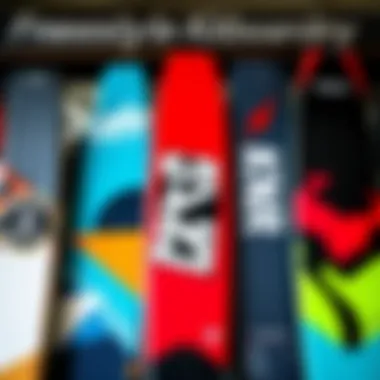
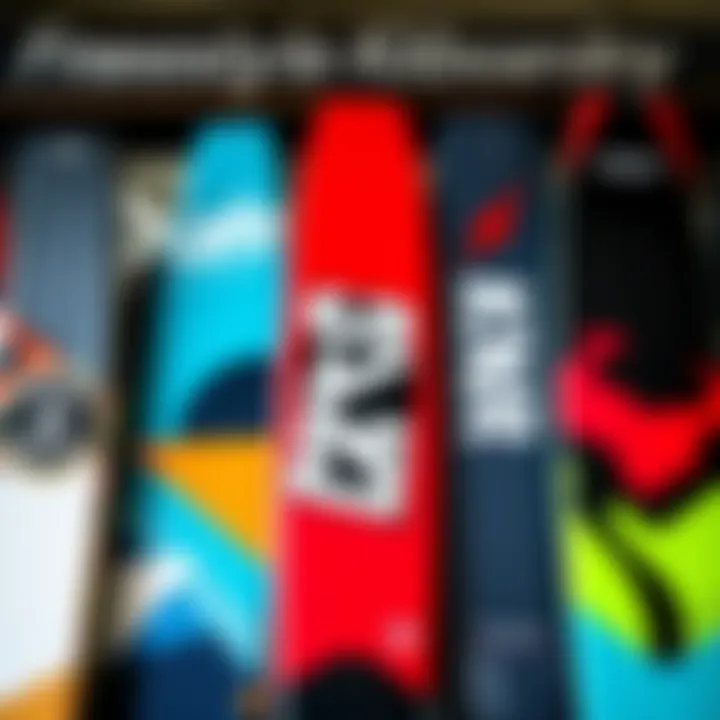
Brand Profiles and Innovations
Brand A Overview
A notable player in the freestyle board arena is North Kiteboarding. Their commitment to performance and innovation shines through their offerings. North boards are known for their progressive design, particularly the hybrid shapes that cater to both flat water and choppy conditions.
One key caracteristic of North Kiteboarding is their use of advanced materials that reduce weight while ensuring durability. This makes their boards a popular choice, especially among riders who love to jump and trick. One standout product, the North Click Bar, utilizes smart technology for an enhanced riding experience. The seamless integration of features is an edge for freestylers looking for precision and responsiveness.
However, their premium pricing can be a barrier for some. Still, the performance advantages often outweigh the cost, making them a strong contender worth considering.
Brand B Overview
Another heavy hitter in the freestyle scene is Liquid Force. Their boards are widely celebrated for their playful nature and forgiving ride. One of the standout traits of Liquid Force is adaptability; their boards cater to a wide range of skill levels and riding styles.
For instance, the Liquid Force Rocket series is particularly well-regarded for beginners and those looking for a freestyle board that offers plenty of pop without being overly challenging to control. Liquid Force’s emphasis on craftsmanship translates to products that are not only functional but also stylish. Their unique feature, the Flex Track System, allows for customized flex patterns, making it easier for riders to fine-tune their experience.
That said, some advanced riders might find Liquid Force boards lacking in the responsiveness needed for high-level competitions. However, their friendly approach to design is a solid win for those digging their feet into the freestyle world.
Brand Overview
Finally, Slingshot deserves a mention for their innovative spirit and distinctive style. Known for their robust build, Slingshot boards often feature cutting-edge technology that enhances maneuverability and durability. The Slingshot Cypher, for instance, boasts a unique flex pattern that maximizes pop while minimizing weight, allowing for a responsive ride.
What sets Slingshot apart is their eco-friendly approach to the manufacturing process. They utilize sustainable materials and practices, appealing to the environmentally conscious rider. This innovation can give riders an extra feel-good factor, similar to riding waves knowing you're making a positive impact.
However, the durability of their boards comes with trade-offs—some riders report a slightly heavier feel compared to competitors, which might not suit every style. But for those willing to embrace a slightly sturdier option, Slingshot delivers on performance and conscience.
"Choosing the right brand can transform your kiteboarding journey, enhancing not just your skills but also your enjoyment on the water."
In summary, exploring the top brands in freestyle kiteboarding is a key step in selecting the perfect board to fit your riding style and performance goals. From North Kiteboarding’s advanced materials in the premium segment to Liquid Force’s adaptability and Slingshot's sustainable practices, each brand offers something distinct for kiteboarders to consider.
Future Trends in Freestyle Boards
The world of freestyle kiteboarding is ever-evolving, and staying ahead of the curve is essential for any serious rider. As technology advances and environmental awareness grows, the trends shaping freestyle boards indicate a shift towards enhanced performance and sustainability. Understanding these trends not only helps enthusiasts improve their skills but also prepares them for innovations that can redefine their kiteboarding experience.
Technological Advancements
In recent years, technological advancements have taken center stage in the kiteboarding industry. The introduction of smart materials has led to boards that are lighter and more responsive than ever before. Here are some noteworthy trends:
- Carbon Fiber Reinforcement: Many top brands are now integrating carbon fiber into their board designs, reducing weight while enhancing strength. This technology allows for increased durability without sacrificing performance, making it easier to land tricks without worrying about damaging the board.
- 3D Printing: Some manufacturers are experimenting with 3D printing to create custom components, providing riders an opportunity for entirely personalized boards. As this technology becomes more accessible, we may very well see a boom in bespoke designs tailored to individual preferences.
- Data Tracking: Boards equipped with sensors can collect data on speed, height, and even balance. This technology allows riders to analyze their performance in real-time, offering insights that can improve skills faster. Imagine having a virtual coach on your board!
With these innovations, riders are not just limited to trying new styles, but can also enhance their learning process through tech-driven feedback.
Sustainability in Design
The growing emphasis on sustainability in design is another trend shaping the future of freestyle boards. Riders and brands alike are becoming more conscious of their environmental impact. This has resulted in the development of sustainable materials and practices. Key elements include:
- Recycled Materials: Some manufacturers are beginning to use recycled plastics and other materials in their boards. This reduces waste and offers a way to turn old products into new, high-quality equipment.
- Eco-Friendly Adhesives: In the construction of boards, the adhesives used can significantly impact the environment. Using low-VOC (volatile organic compounds) adhesives not only makes the boards safer for users but also less harmful to the planet.
- Sustainable manufacturing processes: Companies are exploring more sustainable production methods which reduce energy consumption and waste by utilizing cleaner technologies.
"Riding with a focus on sustainability not only feels good but helps protect our oceans and shores for future generations."
This environmentally conscious approach isn't just good for the planet; it resonates with many riders who want to be part of a more responsible community. As these trends continue to gain traction, freestyle boards are not only becoming better performing but also more environmentally friendly.
Ending
The importance of the conclusion in this guide lies in its ability to synthesize the myriad insights garnered throughout the article. For kiteboarders, whether they are starting out or are seasoned pros, the considerations outlined in previous sections serve as essential touchstones that can vastly improve both their understanding of freestyle boards and their actual riding experiences.
To recap, the main takeaways are:
- Definition and Purpose: Freestyle boards have unique features designed to optimize performance for specific tricks and riding styles.
- Performance Characteristics: These boards prioritize agility, pop, and control, all essential for executing stellar maneuvers.
- Maintenance and Care: Knowledge of proper maintenance ensures the longevity of the board and improves overall performance.
- Common Misconceptions: Addressing misconceptions not only clears up confusion but also empowers riders to make informed decisions about board selection.
- Technological Trends: Keeping abreast of future trends can provide kiteboarders with fresh insights into innovation and sustainability.
Recap of Key Points
In wrapping things up, familiarity with the components and nature of freestyle boards can significantly enhance a rider's performance and enjoyment. Consider these key points:
- Understand the differences between freestyle boards and other types, like freeride or wave boards.
- Pay attention to the characteristics of shape, size, and materials, as these can directly affect the riding experience.
- Regularly maintaining the board by cleaning and storing it properly can lengthen its lifespan significantly.
"The only limits in kiteboarding are your own creativity and willingness to explore."
Encouragement for Exploration
It's worth noting that kiteboarding is as much about personal expression as it is about performance. Experimentation will yield the best learning experiences. Try different boards, techniques, and conditions. Engage with the community through forums like Reddit or follow the latest trends on platforms such as Facebook. Each session on the water is an opportunity to refine skill and discover one’s own style. In a sport that thrives on progression, the notions of learning and exploration should never stop. So, get out there, embrace the wind, and make each ride a new adventure!


